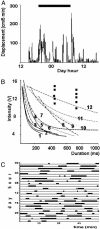Slow wave sleep in crayfish
- PMID: 15286285
- PMCID: PMC511064
- DOI: 10.1073/pnas.0402015101
Slow wave sleep in crayfish
Abstract
Clear evidence of sleep in invertebrates is still meager. Defined as a distinct state of reduced activity, arousability, attention, and initiative, it is well established in mammals, birds, reptiles, and teleosts. It is commonly defined by additional electroencephalographic criteria that are only well established in mammals and to some extent in birds. Sleep states similar to those in mammals, except for electrical criteria, seem to occur in some invertebrates, based on behavior and some physiological observations. Currently the most compelling evidence for sleep in invertebrates (evidence that meets most standard criteria for sleep) has been obtained in the fruit fly Drosophila melanogaster. However, in mammals, sleep is also characterized by a brain state different from that at rest but awake. The electrophysiological slow wave criterion for this state is not seen in Drosophila or in honey bees. Here, we show that, in crayfish, a behavioral state with elevated threshold for vibratory stimulation is accompanied by a distinctive form of slow wave electrical activity of the brain, quite different from that during waking rest. Therefore, crayfish can attain a sleep state comparable to that of mammals.
Figures




References
-
- Rattenborg, N. C. & Amlaner, C. J., Jr. (2002) in Phylogeny of Sleep, Sleep Medicine, eds. Lee-Chiong, T. L., Sayeia, T. L. & Carskadon, M. A. (Hanley and Belfus, Philadelphia), pp. 7-22.
-
- Campbell, S. S. & Tobler, I. (1984) Neurosci. Biol. Behav. Rev. 8, 269-300. - PubMed
-
- Tobler, I. & Stadler, J. J. (1988) Comp. Physiol. 163, 227-235.
-
- Hendricks, J. C., Finn, S. M., Panckeri, K. A., Chavkin, J., Williams, J. A., Sehgal, A. & Pack, A. I. (2000) Neuron 25, 129-138. - PubMed
-
- Shaw, P. J., Cirelli, C., Greenspan, R. J. & Tononi, G. (2000) Science 287, 1834-1837. - PubMed
Publication types
MeSH terms
LinkOut - more resources
Full Text Sources
Other Literature Sources

